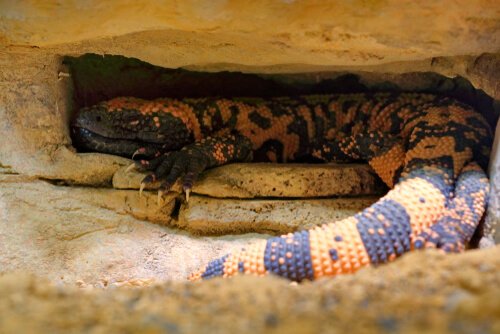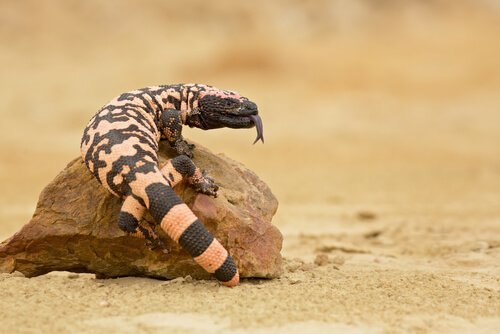Meet the Gila monster
It is one of the few poisonous lizards that exist and, for this reason, the human being fears and fights it . However, its slow gait makes it unlikely that it will attack and bite a person. And, although it usually does not exceed half a meter in length and does not weigh a kilogram, it is known as the monster of Gila.
A lizard with bad reputation
The Heloderma suspectum lives in arid areas of North America . It is found up to 1 500 meters of altitude in the southwest of the USA (Utah, Nevada, California, Arizona) and in the northwest of Mexico (Sonora, Sinaloa).
This lizard has two subspecies : the reticulate ( Heloderma suspectum suspectum ) and the banded ( Heloderma suspectum cinctum ). It owes its name to the fact that, long ago, it was able to abound in areas near the Gila River.
Its body is robust, the tail is short but thick and rounded, and the legs are also short and with claws. Most of the specimens have spots or pints orange, yellow, pink or red that are interspersed in a scaly skin of black or dark brown color.
In his big head, flattened and of quadrangular format they emphasize the snout flat and the eyes of small size. In addition, your language is forked : ends in two points.

We present you the Gila monster, a poisonous lizard that lives in arid areas of northern America. Despite its bad reputation, a substance present in its saliva is used for the treatment of diabetes.
Other information about Heloderma suspectum
The Gila monster spends much of its time in holes it digs or in abandoned burrows . He usually lives alone, but he can share refuge with other congeners.
They feed mainly on eggs, small vertebrates, worms, insects and carrion . And, since he can spend long periods without eating, when he does, he ingests large quantities.
For this reason, he also accumulates fat in his tail. So it survives during hibernation or at times when food is scarce .
What else should you know about the Gila monster?
The poisonous glands that it possesses are located in the jaw . They have channels to the teeth, which enable the entrance of neurotoxic venom into the wound of their prey. In any case, it has been proven that they only use it when they feel threatened.

The males usually fight among themselves for the female members of the species. After mating, the females deposit between 3 and 15 eggs at the bottom of the caves they inhabit .
The offspring are born several months later, depending on the heat of the burrow, and take care of themselves . They reach sexual maturity between four and five years.
A species beneficial to human health
With a life expectancy of between 12 and 16 years, it can reach the 20. And, according to the International Union for the Conservation of Nature (IUCN), is an animal that is 'almost threatened'.
Its main enemy, once again, it is the man, who destroys their habitat, hunts them to sell them as exotic pets or kills them for fear of their poison. In any case, at present the species is protected in all the places where it is found.
However, more than being scared by the unlikely deadly consequences of its bite, the human being should thank the monster of Gila the benefits it brings.


